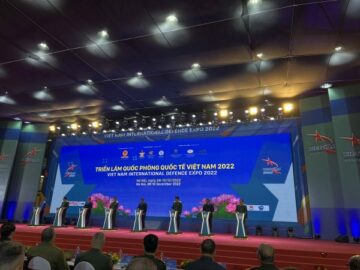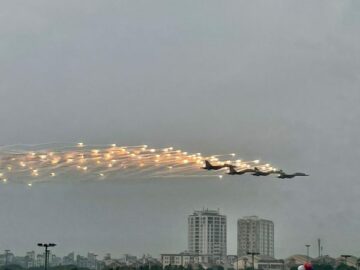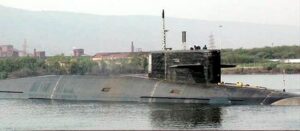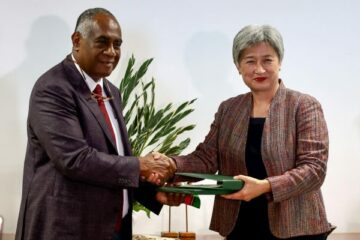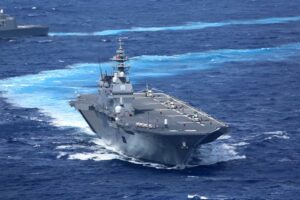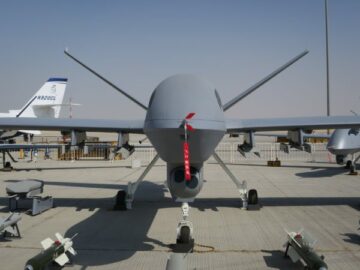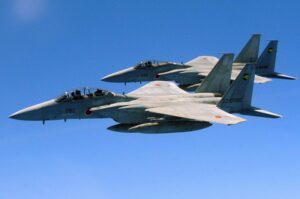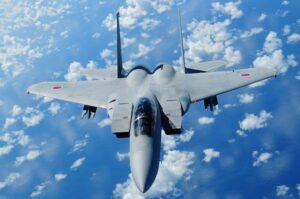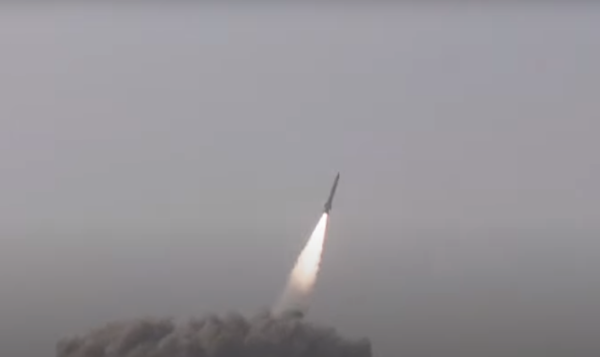
Pakistan unveiled its new guided multiple-launch rocket system (G-MLRS), Fatah-II, on December 27. The Fatah-II is a successor to Fatah-I and a new entry into Pakistan’s conventional strike package. It is distinct from its predecessor because of its long range and enhanced precision.
The rocket is intended to diversify the conventional targeting options for Pakistan by enabling it to conduct precision strikes deep into Indian territory against a variety of targets with various types of conventional warheads. Fatah-II’s development happened in response to the Indian limited war doctrine and is meant to ensure Pakistan’s capability of retaliating with surgical precision.
Fatah-II is not a new system but an addition to the existing G-MLRS club worldwide. Examples include the United States’ M142 High Mobility Artillery Rocket System (HIMARS) and China’s Weishi rocket series. The Fatah-II seems to be a two-round G-MLRS, based on the video released by Pakistan’s military media wing. The rocket is “equipped with state-of-the-art avionics, sophisticated navigation system, and unique flight trajectory,” according to the official press release. It can effectively engage adversaries’ targets within a 400 km range, with a circular error probable (CEP) of less than 10 meters. According to Pakistani news sources, the enhanced precision results from using a combination of inertial and satellite navigation systems.
A few questions arise here. Why did Pakistan introduce a long-range artillery system when it already possesses short-range ballistic missiles (SRBMs) with similar ranges? What benefits are associated with the Fatah-II rocket? The answer lies in Fatah-II’s lower costs, ability to conduct deep strike missions, short sensor-to-shooter response time, and precision strike capability.
Fatah-II provides more bang for Pakistan’s buck because it has low production and operational costs compared to sensitive systems like SRBMs. Ballistic missiles have high maintenance and operational costs and require separate storage sites and staff to maintain them, while Fatah-II can easily blend with the MLRS fleet. Besides, the sensor-to-shooter response time of Fatah-II is significantly shorter, making it a preferable choice for operational commanders.
Moreover, Fatah-II’s extended range of 400 km enables it to eliminate the enemy’s strategic long-range air defense systems deployed in the rear. For instance, it can take out even mobile targets like S-400 air defense systems that can quickly shift from one firing location to another. Additionally, its low cost incentivizes the military to employ it against enemy air defenses by firing a barrage of rockets on a single battery of S-400 to overwhelm the system and, in the process, eliminate it as well. This makes Fatah-II a unique system in Pakistan’s conventional arsenal to perform suppression of enemy air defenses (SEAD) missions in the future.
Having discussed the operational utility of Fatah-II, it is necessary to look at the deterrence dimensions of the novel system. Fatah-II is a response to the Indian limited war doctrine known as the Cold Start Doctrine (CSD). Ever since the doctrine announcement in 2004, the Indian military has been continuously engaged in operational maneuvers to reduce its mobilization time to launch coordinated surprise attacks on multiple fronts against Pakistan. Moreover, its core element, Integrated Battle Groups (IBGs), a tailored force to launch a rapid incursion into Pakistan’s territory, have been tested and embedded with the Indian Army Corps deployed along the Pakistan border.
For instance, Jane’s defense revealed in September 2022 that the concept of IBGs has already been test-bedded with Amy’s 9 Corps on the western border with Pakistan, and further units will be rolled out in a phased manner shortly. This is a significant development in the operationalization of IBGs, posing a significant threat to Pakistan in the conventional realm.
The development was also acknowledged by current Indian Army Chief General Manoj Pande when he emphasized the conversion of the whole army into battle groups. Last January, he explicitly indicated that with “force structuring and optimization, we are converting our forces into IBGs, which will contribute effectively to modern warfare.” The statement indicated that once the conversion process is completed, it will pave the way for the Cold Start Doctrine to go hot at any time.
Additionally, the Indian Army, the largest in numbers among its sister forces and the mastermind behind the pre-emptive CSD doctrinal concept, still has the majority of its strike and holding corps oriented toward Pakistan, although India claims to be prepared for a two-front war scenario. Moreover, the combat and logistics support elements in the Indian Army were previously part of divisions in peacetime and suballotted to brigades during operations. Now, in restructuring toward the adaptation of IBGs, they have been permanently placed under brigades, meaning the force can be launched at a moment’s notice, and they do not have to look toward the division to provide them with supporting elements. This measure was adopted for the rapid launch of IBGs, designed solely to launch against Pakistan as part of CSD requirements.
In that context, Fatah-II strengthens Pakistan’s conventional strike capabilities, allowing it to conduct interdiction missions deep into the enemy heartland. For the first time, rear Indian military bases, ammunition depots, logistics hubs, and air bases are within the striking range of Pakistan’s conventional artillery munitions.
To summarize, Fatah-II validates the presence of land interdiction tactics in the Pakistan Army’s conventional warfighting strategy to delay, disrupt, and destroy Indian IBGs advancing towards Pakistan’s border. To effectively accomplish such a mission requires long-range artillery, and in the form of Fatah-II Pakistan’s army has a perfect conventional counterforce weapon.
- SEO Powered Content & PR Distribution. Get Amplified Today.
- PlatoData.Network Vertical Generative Ai. Empower Yourself. Access Here.
- PlatoAiStream. Web3 Intelligence. Knowledge Amplified. Access Here.
- PlatoESG. Carbon, CleanTech, Energy, Environment, Solar, Waste Management. Access Here.
- PlatoHealth. Biotech and Clinical Trials Intelligence. Access Here.
- Source: https://thediplomat.com/2024/01/understanding-pakistans-rationale-for-the-fatah-ii-rocket/
- :has
- :is
- :not
- 2022
- 400
- 9
- a
- ability
- accomplish
- According
- acknowledged
- adaptation
- addition
- Additionally
- adopted
- advancing
- against
- AIR
- Allowing
- along
- already
- also
- Although
- ammunition
- among
- an
- and
- Announcement
- Another
- answer
- any
- ARE
- arise
- Army
- Arsenal
- AS
- associated
- At
- Attacks
- barrage
- based
- battery
- Battle
- BE
- because
- been
- behind
- benefits
- besides
- Blend
- border
- but
- by
- CAN
- capabilities
- capability
- chief
- Chinas
- choice
- claims
- club
- Cms
- cold
- combination
- compared
- Completed
- concept
- Conduct
- context
- continuously
- contribute
- conventional
- Conversion
- converting
- coordinated
- Core
- Cost
- Costs
- Current
- deep
- Defense
- delay
- deployed
- designed
- destroy
- Development
- DID
- dimensions
- discussed
- Disrupt
- distinct
- diversify
- Division
- do
- during
- easily
- effectively
- element
- elements
- eliminate
- embedded
- emphasized
- enables
- enabling
- engage
- engaged
- enhanced
- ensure
- entry
- error
- Even
- EVER
- examples
- existing
- explicitly
- extended
- few
- firing
- First
- first time
- FLEET
- flight
- For
- Force
- Forces
- form
- from
- further
- future
- General
- Go
- Group’s
- guided
- happened
- Have
- he
- Heartland
- here
- High
- holding
- HOT
- HTTPS
- Hubs
- in
- incentivizes
- include
- india
- Indian
- indicated
- instance
- integrated
- intended
- into
- introduce
- IT
- ITS
- January
- known
- Land
- largest
- Last
- launch
- launched
- less
- lies
- like
- Limited
- location
- logistics
- Long
- Look
- Low
- lower
- maintain
- maintenance
- Majority
- MAKES
- Making
- manner
- meaning
- meant
- measure
- Media
- Military
- missiles
- Mission
- missions
- Mobile
- mobility
- mobilization
- Modern
- Modern Warfare
- more
- Moreover
- multiple
- Navigation
- necessary
- New
- news
- Notice..
- novel
- now
- numbers
- of
- official
- on
- once
- ONE
- operational
- Operations
- optimization
- Options
- our
- out
- package
- Pakistan
- part
- pave
- perfect
- perform
- permanently
- Phased
- placed
- plato
- Plato Data Intelligence
- PlatoData
- possesses
- Precision
- predecessor
- preferable
- prepared
- presence
- press
- Press Release
- previously
- process
- Production
- provide
- provides
- Questions
- quickly
- range
- ranges
- rapid
- rationale
- realm
- reduce
- release
- released
- require
- Requirements
- requires
- response
- restructuring
- Results
- Revealed
- rocket
- Rolled
- satellite
- scenario
- sensitive
- separate
- September
- Series
- shift
- Short
- Shortly
- significant
- significantly
- similar
- since
- single
- sister
- Sites
- solely
- sophisticated
- Sources
- Staff
- start
- state-of-the-art
- Statement
- Still
- storage
- Strategic
- Strategy
- Strengthens
- strike
- Strikes
- structuring
- such
- summarize
- support
- Supporting
- suppression
- surgical
- surprise
- system
- Systems
- tactics
- tailored
- Take
- targeting
- targets
- territory
- tested
- than
- that
- The
- The Future
- Them
- they
- this
- threat
- time
- to
- toward
- towards
- trajectory
- types
- under
- understanding
- unique
- United
- units
- unveiled
- using
- utility
- validates
- variety
- various
- Video
- war
- was
- Way..
- we
- WELL
- were
- Western
- What
- when
- which
- while
- whole
- why
- will
- Wing
- with
- within
- worldwide
- zephyrnet

